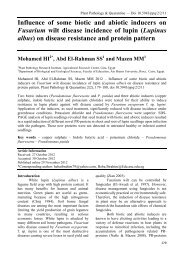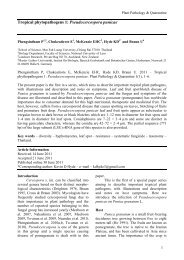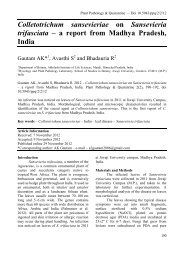Genus Cercospora in Thailand: Taxonomy and Phylogeny (with a ...
Genus Cercospora in Thailand: Taxonomy and Phylogeny (with a ...
Genus Cercospora in Thailand: Taxonomy and Phylogeny (with a ...
Create successful ePaper yourself
Turn your PDF publications into a flip-book with our unique Google optimized e-Paper software.
Key to the treated species <strong>in</strong> <strong>Thail<strong>and</strong></strong>,<br />
arranged by host family<br />
Acanthaceae<br />
1. Stromata lack<strong>in</strong>g or rudimentary; conidiophores<br />
relatively short, 16–60 × 3–6.5 µm,<br />
geniculate; on Andrographis ........................<br />
...................................C. <strong>and</strong>rographidicola<br />
1. Stromata small, 20–24 μm diam.; conidiophores<br />
long, 85–209 × 3–4 μm, slightly<br />
geniculate near the apex; on Barleria .........<br />
.............................................. C. barleriicola<br />
Adiantaceae<br />
A s<strong>in</strong>gle species, on Doryopteris ...................<br />
..............................................C. adiantigena<br />
Amaranthaceae<br />
1. Caespituli hypohyllous; stromata often<br />
lack<strong>in</strong>g, if present, small, up to 8 μm diam.;<br />
conidiophores up to 5 <strong>in</strong> loose fascicles,<br />
long, 90.5–192 × 3–4 μm; conidia acicular,<br />
8–316 × 3–4 μm, 10–22-septate; on Ires<strong>in</strong>e<br />
<strong>and</strong> Celosia ............. <strong>Cercospora</strong> canescens<br />
1. Caespituli amphigenous ............................. 2<br />
2. Conidiophores up to 13 <strong>in</strong> moderately dense<br />
fascicles, 34–85 × 2.5–5 μm; conidia<br />
acicular, 12–67 × 2.5–3.5 μm, 4–7-septate;<br />
on Celosia....................<strong>Cercospora</strong> celosiae<br />
2. Stromata small, 12–26 μm diam.; conidiophores<br />
5–9 <strong>in</strong> loose <strong>and</strong> divergent fascicles,<br />
47–125 × 3–5 μm; conidia narrowly obclavate<br />
to subacicular, 29–168.5 × 2.5–3.5 μm,<br />
2–12-septate; on Ric<strong>in</strong>us ..............................<br />
.................................... <strong>Cercospora</strong> ric<strong>in</strong>ella<br />
Apocynaceae<br />
A s<strong>in</strong>gle species, on Pental<strong>in</strong>o .........................<br />
.................................. <strong>Cercospora</strong> peregr<strong>in</strong>a<br />
Arecaceae<br />
A s<strong>in</strong>gle species, on Areca ...............................<br />
.............................<strong>Cercospora</strong> arecacearum<br />
Asteraceae<br />
1. Caespituli hypophyllous.............................2<br />
Plant Pathology & Quarant<strong>in</strong>e<br />
1. Caespituli amphigenous ............................. 4<br />
2. Conidiophores sometimes branched, 55–181<br />
× 4–5.5 μm; on Artemisia.............................<br />
................................. <strong>Cercospora</strong> artemisiae<br />
2. Conidiophores unbranched......................... 3<br />
3. Conidiophores 79–184 × 3–5 μm, geniculate;<br />
conidia 120–215 × 3–4 μm, narrowly<br />
obclavate to acicular, 8–20-septate, obconically<br />
truncate at the base; on Helianthus<br />
............................ <strong>Cercospora</strong> helianthicola<br />
3. Conidiophores 25–102 × 25–4 μm, not<br />
geniculate; conidia 46–87 × 2.5–3 μm,<br />
acicular, 7–10-septate, truncate at the base;<br />
on Dahlia..................<strong>Cercospora</strong> dahliicola<br />
4. On Z<strong>in</strong>nia ................................................... 5<br />
4. On other hosts ............................................ 6<br />
5. Conidiophores unbranched, 54–100 × 2.5–5<br />
μm; conidia 24.5–93.5 × 2.5–3.5 μm,<br />
filiform to narrowly obclavate, 7–18-septate;<br />
on Z<strong>in</strong>nia elegans .....<strong>Cercospora</strong> z<strong>in</strong>niicola<br />
5. Conidiophores sometimes branched, 40–152<br />
× 3–5.5 μm; conidia 24–175 × 2–3.5 μm,<br />
narrowly obclavate to subacicular, 4–13septate;<br />
on Z<strong>in</strong>nia gr<strong>and</strong>iflora......................<br />
...................................... <strong>Cercospora</strong> z<strong>in</strong>niae<br />
6. Conidiophores not geniculate or rarely<br />
geniculate, 32.5–220 × 3–8 μm; conidia 45–<br />
196 × 1.5–3 μm, acicular, 13–19-septate,<br />
truncate at the base; on Cynara....................<br />
..................................... <strong>Cercospora</strong> cynarae<br />
6. Conidiophores dist<strong>in</strong>ctly geniculate........... 7<br />
7. Conidia obclavate or subacicular ............... 8<br />
7. Conidia acicular ......................................... 9<br />
8. Conidia obclavate, 80–96 × 3.5–4 μm; on<br />
Conyza...................<strong>Cercospora</strong> nilghirensis<br />
8. Conidia narrowly obclavate to subacicular,<br />
60–198 × 2–4 μm; on Gerbera.....................<br />
....................................<strong>Cercospora</strong> gerberae<br />
9. Conidia truncate at the base, 23–190 × 2–4<br />
μm, 3–10-septate; on Chrysanthemum<br />
............................<strong>Cercospora</strong> chrysanthemi<br />
9. Conidia obconically truncate at the base, 36-<br />
182 × 3–6.5 μm, 7–13-septate; on Lactuca<br />
........................<strong>Cercospora</strong> lactucae-sativae<br />
27









